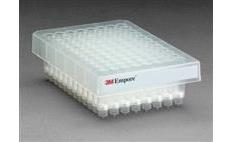Empore™ 96-Well SPE Extraction Plates, type C8 and C18
home >
extraction >
empore™ 96-well spe extraction plates, type c8 and c18
You have not viewed any products recently.

View Larger
Empore™ 96-Well SPE Extraction Plates, type C8 and C18
96-Well Plates
Empore™ 96-Well Plates provide a means of high throughput sample preparation by processing 96 samples in a standard 8x12 microcolumn plate format compatible with standard 96-well plate liquid handling technologies and injection systems. Empore 96-Well Plates are available for solid phase extraction (SPE) and for filtration after protein precipitation.
Extraction Disk Plates for SPE
Empore High Performance Extraction Disk Plates are designed for solid phase extraction (SPE) of analytes from biological samples. Parallel sample processing allows 96 samples to be extracted in approximately one hour or less. Each well of the plate contains a standard density Empore particle-loaded membrane for efficient sample extraction. Elution can be accomplished in as little as 100µL with mobile phase or mobile phase compatible solutions for direct injection onto chromatographic systems. Extraction disk plates are ideal for sample preparation prior to LC/MS and other high throughput analytical instruments.
The Empore Extraction Disk Plates are available for small volume applications up to 1.2mL in the standard 96-well plates or for larger volume samples up to 2.5mL in deep well plates.
Sorbent Information
Bonded silica sorbents are commonly used for the solid phase extraction of analytes from complex sample matrices. Functional groups, such as octyl (C8) and octadecyl (C18), can be bonded to the silica surface to provide non polar interactions. Each of these sorbents exhibits unique properties of retention and selectivity for a particular analyte. The choice of which sorbent is best for a particular method will be influenced by the percent recovery of analyte from the sample matrix and the cleanliness of the resulting chromatography.
Empore™ C8-SD and C18-SD Standard and Deep Well Plates
Bonded silica sorbents are commonly used for the solid phase extraction of analytes from complex sample matrices. These products are intended for use during scientific research only and are not intended for use in medical devices or in assessment and treatment of clinical patients.
Features and Benefits
- Functional groups, such as octyl (C8) and octadecyl (C18), can be bonded to the silica surface to provide non polar interactions
- Each of these sorbents exhibits unique properties of retention and selectivity for a particular analyte
- The choice of which sorbent is best for a particular method will be influenced by the percent recovery of analyte from the sample matrix and the cleanliness of the resulting chromatography
- Ultra-fast flow rate at 350mL/min– 2X faster than other leading brands
- Least elution volume– 1/3 of other leading brands and 1/10 of loose-packed SPE
- Highest consistency & reproducibility– 10-15% higher than Waters Oasis plates
- Least particle fines in eluates-1/10 of other leading brands to increase efficiency >25 (reducing tube clogging & system downtime
Specifications
| |
C18 |
C8 |
| Bonded Functional Group |
Octadecyl |
Octyl |
| Retention Mechanism |
Strongly non polar |
Moderately non polar |
| Endcapped |
Yes |
Yes |
| Percent Carbon (avg.) |
18% |
12% |
| Pore Size (avg.) |
60 Å |
60 Å |
Applications
- Opiates
- THC
- Antibiotics
- Bronchodilators
- Pesticides
- Hypnotics
- Antiarrhythmics
- Vasodilators
- Antidepressants
- Benzodiazepines
- Corticosteroids
- Anticonvulsants
- Peptides
- Antihypertensives
- Analgesics
- Immunomodulators
Product Usage
- The versatile Empore C8 and C18 products allow for use in the following applications
- The small bed volume and sorbent mass within Empore Extraction Disk Cartridges and 96-well Solid Phase Extraction Plates allow for the use of reduced solvent volumes and result in more concentrated eluates
- In HPLC methods, the ability to direct inject is now possible when the eluate is compatible with mobile phase
- Time-consuming evaporation and reconstitution steps may be eliminated
- Recoveries may be improved by avoiding analyte thermal instability problems associated with an evaporation step